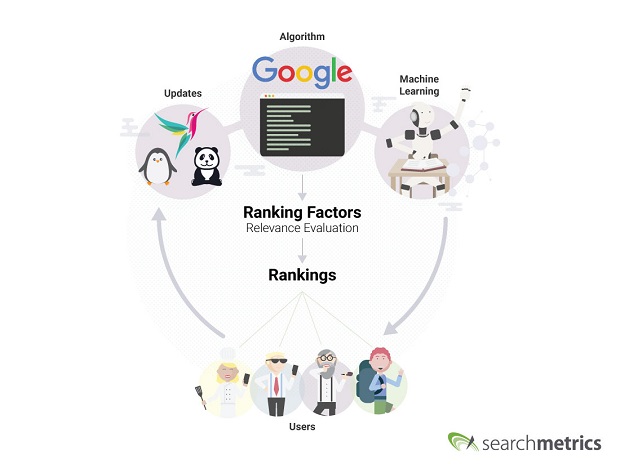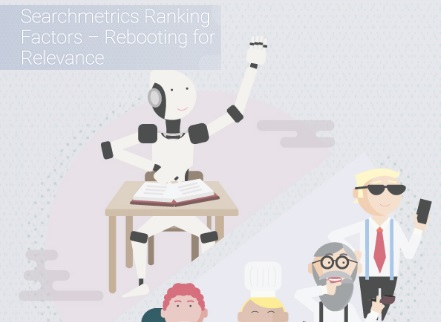Google’s use of machine learning and artificial intelligence to better understand people’s search intentions and surface the most relevant results is paying off according to new research.
Today’s search results are more relevant than ever, while many simplistic techniques that marketers use to artificially help their pages rank higher ‒ such as collecting more backlinks and increasing the number of times keywords are mentioned in text – are becoming less effective.
The findings come from Searchmetrics’ annual study of Google Ranking Factors which analysed the top 20 search results for 10,000 keywords on Google.com. The aim of the analysis (carried out every year since 2012) is to identify the key factors that high ranking web pages have in common, providing generalised insights and benchmarks to help marketers, SEO professionals and webmasters.
“Google revealed last year that it is turning to sophisticated AI and machine-learning techniques, such as its RankBrain system, to help it better understand the real intention behind the words that searchers enter in the search box and make its results more relevant,” explains Marcus Tober, Searchmetrics’ Founder and CTO. “And with the help of user signals such as how often certain results are clicked and how long people spend there, the search engine gets a sense of how well searchers’ questions are answered; allowing it to continually refine and improve relevance.”
The most relevant content ultimately depends on the user intention Tober goes on to explain:
“A searcher who types ‘Pesto Ingredients’ into the search box is most likely looking for a short list for example; someone who types ‘who won Superbowl 50?’ wants a single piece of information, while a query like ‘halloween costume ideas’ is most likely wanting a series of images and a ‘how to tie a windsor knot’ query might be best served with video content. Our research suggests Google is getting better at interpreting user intent to show the most relevant content.”

Here are five indications from this year’s study that suggest Google is now becoming even better at showing the most relevant results:
1 High ranking pages are significantly more relevant than those that appear lower
Higher ranking search results are significantly more relevant to the search query than those lower down according the study, indicating that Google recognises when content is more relevant and gives it a rankings boost ‒ and this is not simply based on a crude analysis of the number of times web pages mention keywords that match those entered in the search box.
In this year’s study, Searchmetrics has used Big Data techniques to calculate a Content Relevance score¹, a new factor which assesses the semantic relationship between the words entered in search queries and the content shown in results; in effect, it measures how closely they are related. To make Content Relevance more meaningful, its calculation actually excludes instances of simple keyword matches between search queries and search results.
In general the Content Relevance scores of results positioned near the top are higher, suggesting that Google knows when content is more relevant and places it more prominently. This rule does not apply to results found in positions 1 and 2 which tend to be reserved for top brand websites, presumably because Google considers content from brands – as it is more recognisable and trusted – will better serve searchers’ needs than non-brand pages that might have slightly more relevant content. Results with the highest Content Relevance scores appear in results found in positions 3 to 6.
2 Wordcount is increasing on pages that rank higher, while keyword mentions fall
The number of words on higher ranked pages has been increasing for several years now and this trend is continuing. According to Searchmetrics this is because top performing results are more detailed, more holistic (cover more of the important aspects of a topic) and are hence better able to answer search queries.
But interestingly, even as text grows longer, the number of keywords (words that match the search query) on higher ranked pages is not increasing. This is because Google is no longer just trying to reward pages that use more matching keywords with higher rankings; it is trying to interpret the search intention and boosting the content that is most relevant to the query.
In fact the top 20 results include 20% fewer matching keywords (on average) in the copy than in 2015. Also in 2016 just 53% of the top 20 results have the keyword in the title (compared with 75% in 2015) and less than 40% now have the matching keyword in H1 title tag (usually used in the HTML of web pages to tell search engines what the page is about).
On average, pages appearing in desktop results are a third longer than those appearing in mobile search results.
3 User signals suggest Google increasingly guides searchers to exactly the right result
If Google was presenting precisely the right results to answer searchers’ queries, then more of them would visit those pages, take in what is there and leave without having to look elsewhere (having found exactly want they were looking for). And that is just what seems to be happening according to the data.
Searchmetrics’ analysis of user signals indicates that bounce rates (when a searcher visits a page and leaves without clicking more pages on the same site) have risen for all positions in the top 20 search results and for position 1 have gone up to 46% (from 37% in 2014). This is not because more people are bouncing away from pages immediately – having found that the content does not answer their question. Because time-on-site has also increased significantly over previous years, with people spending around 3 minutes 10 seconds on average when they visit pages listed in the top 20 results.
4 Backlinks are becoming less important for a high ranking
The number of backlinks coming into a page from other sites has always been an important common factor among high ranking pages. It still has a strong correlation with pages that rank well, but is on a downward trend as other factors such as those related to the content on the page become more important.
As well as the growing importance of content related factors, backlinks are becoming less important because of the rise of mobile search queries: pages viewed on mobile devices are often ‘liked’ or shared but seldom actively linked to.
5 Google shows more longer URLs to answer search queries, not just optimised short-URL home and landing pages
Until now, marketers and SEO professionals have been able to use optimisation techniques to help their site’s homepage or favoured landing pages ranked higher. But the study shows that the URL addresses for pages that feature in the top 20 search results are around 15% longer on average than in 2015. Searchmetrics’ hypothesis is that instead of the highly optimised home and landing pages that marketers might prefer to appear in searches (and which tend to have short, tidy URLs), Google is better able to identify and display the precise pages that answer the search intention; these pages are more likely to have longer URLs because they possibly lie buried deeper within websites.
Other important findings from the results are
• Technical factors such as loading time, file size, page architecture and mobile friendliness are a pre-requisite for good rankings as these factors help to make web pages easily accessible and easy to consume for both humans and search engines. They lay the foundation for breaking into the top 20 search results with the quality and relevance of the content enabling further rankings improvements.
.
• There are significant differences between high ranking content on desktop devices and that which appears on mobile devices. For example high ranking mobile results tend to have faster page load speeds, smaller file sizes, shorter wordcounts and fewer interactive elements such as menus and buttons.
For marketers and SEO professionals the advice from the study is clear suggests Tober:
“Since Google is becoming much more sophisticated about how it interprets search intent and relevance, you also need to work harder and smarter at understanding and delivering on these areas in content you put on your websites. You need to use data-driven insights to analyse exactly what searchers are looking for when they type specific queries in the search box and make sure your content answers all their questions clearly and comprehensively in the most straightforward way – and you need to do it better than your competitors.”
Google’s application of machine learning to evaluate search queries and web content means that the factors it uses to determine search rankings are changing all the time. They are becoming fluid and vary according the context of the search (is it a travel search? An online shopping search? etc.) and according to the intention behind each individual query. Because of this, Searchmetrics will in future no longer be conducting a single generalised universally applicable ranking factors study. Instead it is planning to publish a completely new series of industry specific ranking factors studies. The first one of these industry specific studies will be published early in 2017.
To download the current Searchmetrics whitepaper for the 2016 study click here.
¹Content Relevance is based on measurement methods which use linguistic corpora and the conceptualisation of semantic relationships between words as distances in the form of vectors. For the semantic evaluation of a text, this makes it possible to analyse the keyword and the content separately from one another. Searchmetrics can calculate a content relevance score for a complete text on a certain keyword or topic. The higher the relevance score, the more relevant the content of the analysed landing page for the given search query.
About the study
As in previous years, the study analysed Google US (Google.com) search results for 10,000 keywords and 200,000 websites, featuring in the top 20 positions. For some factors, a more in-depth analysis required the definition of specially-defined keyword sets. The correlations between different factors and the Google search rankings were calculated using Spearman’s rank correlation coefficient. To provide maximum context this year’s desktop search analysis has been compared either with the equivalent desktop data from previous years or with the mobile data from 2016.

